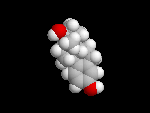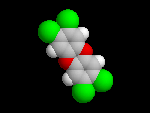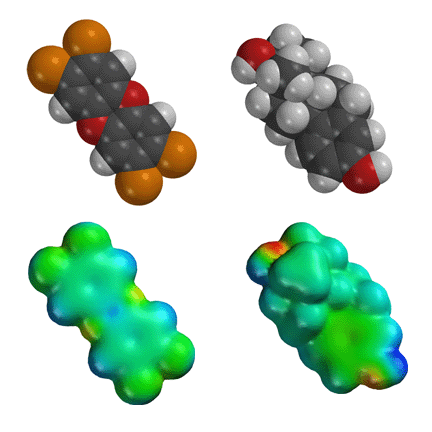


Dioxin is an unwanted contaminant in the very common herbicides 2,4,D and 2,4,5 T (The famous "Agent Orange" used in the Vietnam war). Dioxin results from a side reaction, and is very difficult to remove. It is also a biproduct of other industrial processes such as the paper industry.
Dioxin became the center of a cancer controversy because it was among the most cancer causing substances ever tested in guinea pigs! This lead to public panic and massive efforts to remove dioxin from the environment.
Dioxin is extrememely hydrophobic. This means that dioxin lingers in the environment, it does not wash away with rain. Once ingested by an animal, the hydrophobicity means it accumulates in fat tissue and is not flushed from the body like water soluble compounds. Thus, it can actually become relatively concentrated in animals. All of this made scientists think that dioxin would possibly turn out to be one of the most significant environmental disasters of all time.
However, after much research, it was found that dioxin does not cause cancer in humans like it does in guinea pigs. It is now thought to be a so-called "environmental estrogen". Estrogens are hydrophobic molecules about the same size as dioxin. The dioxin molecule binds to steroid receptors called the Ah receptors. Ah receptors normally bind steroids. With bound steroid, the steroid-Ah receptor complex goes to the cell nucleus, where it binds to DNA in specific places and causes certain genes to be turned on. (This is just like the hydrocortisone steroid receptor story, but these two different classes of steroid receptors activate entirely different genes). The activated genes control a variety of complex functions, and if activated continually and sytemically by exposure to an "environmental estrogen", all kinds of bad things happen, having to do with reproduction, growth, and cancer. The good news is that dioxin binds the guinea pig Ah receptors much more strongly than human Ah receptors, so dioxin is actually not the danger to us it was once feared to be. It is toxic, however, and is by no means safe to be exposed to in large quantity.

A new problem with dioxin in the environment has recently been uncovered. Lake trout are now extinct in Lake Ontario and are very rare in the other great lakes. Dioxin was dumped in the Great Lakes over the decades. Juvenile lake trout are particularly susceptible to dioxin and die before reaching adulthood.
Environmental estrogens (flat, hydrophobic molecules about the size of a steroid) are now known to be major problems in the environment (for example PCB's which are polychlorinated biphenyls), and have species specific effects because it comes down to whether a particular species has an Ah receptor that happens to bind the pollutant or not. These kinds of effects are thought be involved with problems associated with DDT (bird eggshell thinning) and growth abnormalities in some amphibians.
Interesting articles on dioxin, today's molecule of the day describe studies on servicemen exposed to dioxin during the Vietnam war. Despite publicity to the contrary, the scientists could find no significant increased incidence of death, cancer, or immune system problems in these men. Scientists are only now able to understand the complex mode of action of molecules like dioxin